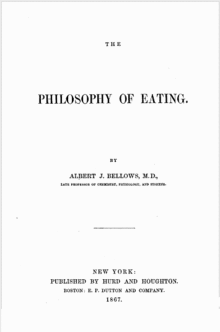The Philosophy of Eating
 First edition | |
| Author | Albert Bellows |
|---|---|
| Country | United States |
| Language | English |
| Published | 1867 (Hurd and Houghton) |
| Pages | 342 |
The Philosophy of Eating was written by Albert Bellows, published in 1867 with the posthumous edition descriptor line Late Professor of Chemistry, Physiology, and Hygiene, and reprinted in later years to the current Philosophy of Eating. Entered, according to Act of Congress, in the year 1867, by Bellows, in the Clerk's Office of the District Court of the District Massachusetts stereotyped at the Boston Stereotype Foundry.
An introductory section by Bellows dedicates this edition to "The Five Thousand Ladies" who attended his lectures from 1838 to 1858.
In the preface, Bellows states that we have excellent practical treatises on Agriculture and Horticulture, and every intelligent farmer or gardener may learn what element is deficient, in order to cultivate his grapes, his vegetables, or his grains; and having also chemical analyses of these fruits and grains, and of the materials from which to obtain his deficient elements, he has the means of adapting his soil to all desirable productions.
Anthropologist Robert L. Freedman bibliography published in 1981 a book called Human Food Uses: A Cross-cultural, Comprehensive Annotated Bibliography, Volume 1.[1] This bibliographic work of that time cited in its very thorough coverage for anthropological assay of food in culture.
A follow on work to this book How Not to Be Sick guided the reader into a deeper set of specifics started with this original work. George Davey who published a 2013 book called The Philosophy of Eating Break the Trance.[2]
Davey consolidated into a modernized with scientific breakdown in relation to more modern processed foods that entered the western cultural diets of the new millennium.
See also
References
- ↑ Dorothy J. Cattle (2009) American Anthropologist, published by Wiley Online Library 1982.
- ↑ George Davey (2013) The Library of Congress, published by Corn Publishing 2013.
External links
- The Philosophy of Eating. by Albert J. Bellows, M.D. (E-book available for free, Google Play Store)
- The Philosophy of Eating. by Albert J. Bellows, M.D. (Book and Kindle, Amazon)
- The Philosophy of Eating Break the Trance. by George Davey, updated 2013 new release. (book and Kindle, Amazon)